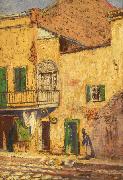China al por mayor de Marco de Oleo |
|||||||||||

|
|||||||||||
|
|
|
||||||||||||||
|
William Woodward
(1 May 1859 - 17 November 1939) was a U.S. artist and educator, best known for his impressionist paintings of New Orleans and the Gulf Coast of the United States. Woodward was born in Seekonk, Massachusetts. His younger brother Ellsworth Woodward also became a notable artist. William Woodward studied art at the Rhode Island School of Design, and later at the Academie Julian where he received instruction from Gustave Boulanger and Jules Lefebvre. View of the Napoleon House in New Orleans, 1904In 1884 Woodward was hired to teach fine art, mechanical drawing, and architectural drawing at Tulane University in New Orleans. He became interested in the history and architecture of the city, especially the old French Quarter, which at the time had become largely neglected with many of the historic structures in a state of decay. In 1895 he led a successful campaign to save the Cabildo from demolition. His series of paintings of French Quarter scenes helped shape awareness of the neighborhood's architectural heritage and spurred the formation of the Vieux Carre Commission to help preserve it. He started teaching architectural engineering at Tulane in 1894 and helped found the Tulane School of Architecture in 1907, as well as the Newcomb School of Art. In 1921 he suffered an accident and used a wheelchair for the rest of his life. He retired from Tulane the following year, and in 1923 moved to Biloxi, Mississippi. He invented the fiberloid dry etching process. He continued to paint and produce etchings for the rest of his life. |
||||||||||||||
|
|
||||||||||||||
|
||||||||||||||
|
|
||||||||||||||
| William Woodward
(1 May 1859 - 17 November 1939) was a U.S. artist and educator, best known for his impressionist paintings of New Orleans and the Gulf Coast of the United States. Woodward was born in Seekonk, Massachusetts. His younger brother Ellsworth Woodward also became a notable artist. William Woodward studied art at the Rhode Island School of Design, and later at the Academie Julian where he received instruction from Gustave Boulanger and Jules Lefebvre. View of the Napoleon House in New Orleans, 1904In 1884 Woodward was hired to teach fine art, mechanical drawing, and architectural drawing at Tulane University in New Orleans. He became interested in the history and architecture of the city, especially the old French Quarter, which at the time had become largely neglected with many of the historic structures in a state of decay. In 1895 he led a successful campaign to save the Cabildo from demolition. His series of paintings of French Quarter scenes helped shape awareness of the neighborhood's architectural heritage and spurred the formation of the Vieux Carre Commission to help preserve it. He started teaching architectural engineering at Tulane in 1894 and helped found the Tulane School of Architecture in 1907, as well as the Newcomb School of Art. In 1921 he suffered an accident and used a wheelchair for the rest of his life. He retired from Tulane the following year, and in 1923 moved to Biloxi, Mississippi. He invented the fiberloid dry etching process. He continued to paint and produce etchings for the rest of his life. Date 1909 ttd |
||||||||||||||
|
Related Paintings to William Woodward :. |
||||||||||||||
|
|
||||||||||||||
|
|
||||||||||||||
|
CONTACTE EEUU |







